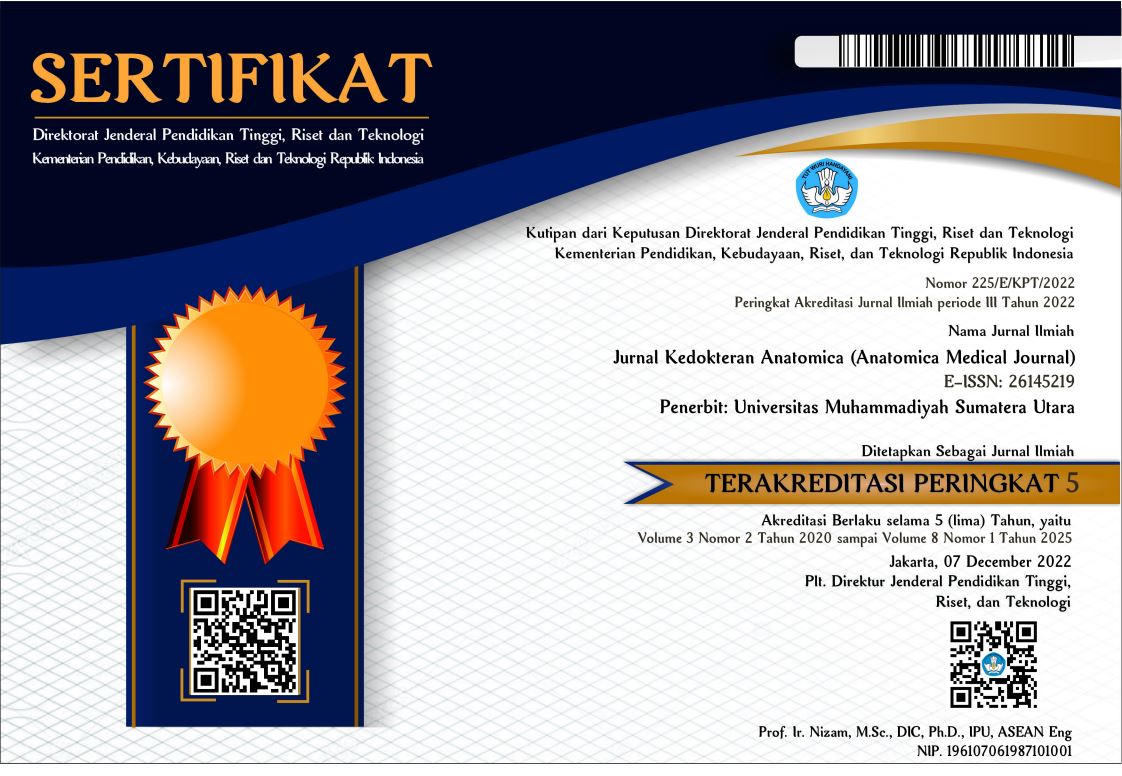Flush Cairan pada Jarum Spinal 27-Gauge Tipe Quincke Mempercepat Waktu Munculnya Cerebrospinal Fluid (CSF) sebagai Penanda Keberhasilan Mencapai Ruang Subarakhnoid pada Tindakan Anestesi Spinal
Abstract
ABSTRACT
Background: There are currently various sizes and shapes of spinal needles designed to prevent post-dural puncture headache (PDPH). Spontaneous CSF flow is very slow on fine spinal needles which impacts prolonging the duration of the procedure and resulting in repeated punctures in the dura mater.
Aim. To Evaluate 0.5% 0.2 mL bupivacaine filling into the Quincke 27G needle before insertion is a fast and simple method for identifying the appearance of CSF under spinal anesthesia.
Methodology. After obtaining approval from the ethics committee, a cross-sectional study was conducted on 100 pregnant women, aged 18-40 years, ASA I and II status, who underwent elective cesarean section, and sought written approval. Subjects were randomized into 2 groups. A (n = 50) used a 27G Quincke spinal needle (Spinocan, B.Braun Melsunger) filled with 0.5% bupivacaine 0.2 ml before being inserted into the L3-L4 space and group B (n = 50) as a control. The time from when the stylet was pulled until the appearance of CSF on the hub was calculated using a stopwatch.
Results. There were no significant differences between the two groups in age and ASA physical status. The mean time for CSF to appear was significantly shorter in group A than in group B (6.26 vs 16 seconds;p= 0.000).
Conclusion. This method can be used to identify the emergence of CSF in a shorter of time, simpler and easier to do.
Keywords: fine spinal needle, cerebrospinalfluid (CSF), post-dural puncture headache (PDPH)Full Text:
PDFReferences
Tsen LC. Anesthesia for Cesarean Delivery. Polley LS, Tsen LC, Wong CA Chesnut DH. Chestnut's obstetric anesthesia : principles and practice. fourth. Mosby Elsevier. 2009: 521-73
Hoyt MR. Anesthesia for Cesarean Delivery. Segal S, Preston RL, Fernando R, Mason CL Suresh MS. Shnider and Levinsons anesthesia for obstetrics. fifth edition. Philadelphia, Lippincott Williams & Wilkins. 201: 165-81
Riley ET, Cohen SE, Macario A, et al. Spinal versus epidural anesthesia for cesarean section: A comparison of time efficiency, costs, charges, and complications. Anesth Analg. 1995, 80: 709-12
Manchikanti L, Hadley C, Markwell SJ, et al. A retrospective analysis of failed spinal anesthetic attempts in a community hospital. Anesth Analg. 1987, 66:363-66
Munhall RJ, Sukhani R, Winnie AP. Incidence and etiology of failed spinal anesthetics in a university hospital. A prospective study. Anesth Analg. 1988, 67;843-48
Parker RK, DeLeo BC, White PF. Spinal anesthesia: 25 GA Quincke vs 25 GA or 27 GA Whitacre needles. Anesthesiology. 1992, 77:A485.
Campbell DC, Douglas MJ, Pavy TJG, et al. Comparison of the 25-gauge Whitacre with the 24-gauge Sprotte spinal needle for elective caesarean section: cost implications. Can J Anaesth. 1993, 40:1131-35.
Kang SB, Romeyn RL, Shenton DW, et al. Spinal anesthesia with 27-gauge needles for outpatient knee arthroscopy in patients 12 to 18 years old. Anesthesiology. 1991, 71:A1103.
Kang SB, Goodnough DE, Lee YK, et al. Spinal anesthesia with 27-gauge needles for ambulatory surgery patients. Anesthesiology. 1990, 73:A2
Lifschitz R, Jedeikin R. Spinal anaesthesia. A new combination system. Anaesthesia. 1992, 47:503-5.
Lesser P, Bembridge M, Lyons G, Macdonald R. An evaluation of a 30-gauge needle for spinal anaesthesia for caesarean section. Anaesthesia. 1990, 45:767-8.
Dahl JB, Schultz P, Anker-Moller E, et al. Spinal anaesthesia in young patients using a 29-gauge needle: technical considerations and an evaluation of postoperative complaints compared with general anaesthesia. Br J Anaesth. 1990, 64:178-82
McIntyre JWR. Anaesthesia monitoring: the human factors component of technology transfer. Int J Clin Monit Comput 1993, 10:23
DOI: https://doi.org/10.30596/anatomica
DOI (PDF): https://doi.org/10.30596/amj.v2i3.3431.g3132
Refbacks
- There are currently no refbacks.
Jurnal Kedokteran Anatomica/ Anatomica Medical Journal (AMJ)
E-mail: amj_fk@umsu.ac.id || Editorial Contact: 081375150018
This work is licensed under aCreative Commons Attribution-ShareAlike 4.0 International License.


.png)
